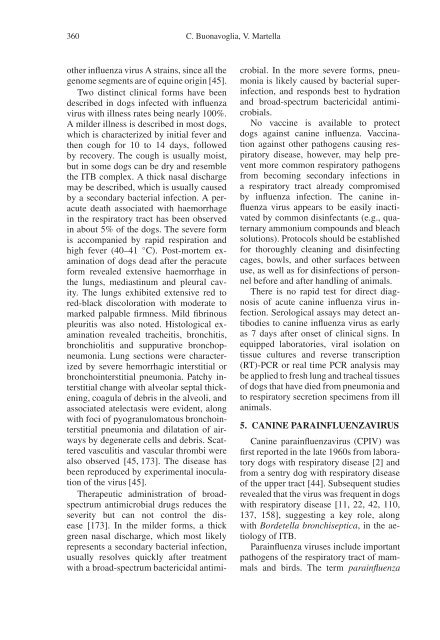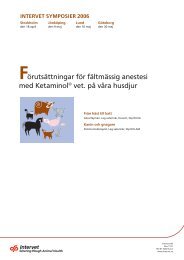KVÄLLSSYMPOSIUM 2008 Vaccinering av hund och katt
KVÄLLSSYMPOSIUM 2008 Vaccinering av hund och katt
KVÄLLSSYMPOSIUM 2008 Vaccinering av hund och katt
Create successful ePaper yourself
Turn your PDF publications into a flip-book with our unique Google optimized e-Paper software.
360 C. Buon<strong>av</strong>oglia, V. Martella<br />
other influenza virus A strains, since all the<br />
genome segments are of equine origin [45].<br />
Two distinct clinical forms h<strong>av</strong>e been<br />
described in dogs infected with influenza<br />
virus with illness rates being nearly 100%.<br />
A milder illness is described in most dogs,<br />
which is characterized by initial fever and<br />
then cough for 10 to 14 days, followed<br />
by recovery. The cough is usually moist,<br />
but in some dogs can be dry and resemble<br />
the ITB complex. A thick nasal discharge<br />
may be described, which is usually caused<br />
by a secondary bacterial infection. A peracute<br />
death associated with haemorrhage<br />
in the respiratory tract has been observed<br />
in about 5% of the dogs. The severe form<br />
is accompanied by rapid respiration and<br />
high fever (40–41 ◦ C). Post-mortem examination<br />
of dogs dead after the peracute<br />
form revealed extensive haemorrhage in<br />
the lungs, mediastinum and pleural c<strong>av</strong>ity.<br />
The lungs exhibited extensive red to<br />
red-black discoloration with moderate to<br />
marked palpable firmness. Mild fibrinous<br />
pleuritis was also noted. Histological examination<br />
revealed tracheitis, bronchitis,<br />
bronchiolitis and suppurative bronchopneumonia.<br />
Lung sections were characterized<br />
by severe hemorrhagic interstitial or<br />
bronchointerstitial pneumonia. Patchy interstitial<br />
change with alveolar septal thickening,<br />
coagula of debris in the alveoli, and<br />
associated atelectasis were evident, along<br />
with foci of pyogranulomatous bronchointerstitial<br />
pneumonia and dilatation of airways<br />
by degenerate cells and debris. Scattered<br />
vasculitis and vascular thrombi were<br />
also observed [45, 173]. The disease has<br />
been reproduced by experimental inoculation<br />
of the virus [45].<br />
Therapeutic administration of broadspectrum<br />
antimicrobial drugs reduces the<br />
severity but can not control the disease<br />
[173]. In the milder forms, a thick<br />
green nasal discharge, which most likely<br />
represents a secondary bacterial infection,<br />
usually resolves quickly after treatment<br />
with a broad-spectrum bactericidal antimi-<br />
crobial. In the more severe forms, pneumonia<br />
is likely caused by bacterial superinfection,<br />
and responds best to hydration<br />
and broad-spectrum bactericidal antimicrobials.<br />
No vaccine is <strong>av</strong>ailable to protect<br />
dogs against canine influenza. Vaccination<br />
against other pathogens causing respiratory<br />
disease, however, may help prevent<br />
more common respiratory pathogens<br />
from becoming secondary infections in<br />
a respiratory tract already compromised<br />
by influenza infection. The canine influenza<br />
virus appears to be easily inactivated<br />
by common disinfectants (e.g., quaternary<br />
ammonium compounds and bleach<br />
solutions). Protocols should be established<br />
for thoroughly cleaning and disinfecting<br />
cages, bowls, and other surfaces between<br />
use, as well as for disinfections of personnel<br />
before and after handling of animals.<br />
There is no rapid test for direct diagnosis<br />
of acute canine influenza virus infection.<br />
Serological assays may detect antibodies<br />
to canine influenza virus as early<br />
as 7 days after onset of clinical signs. In<br />
equipped laboratories, viral isolation on<br />
tissue cultures and reverse transcription<br />
(RT)-PCR or real time PCR analysis may<br />
be applied to fresh lung and tracheal tissues<br />
of dogs that h<strong>av</strong>e died from pneumonia and<br />
to respiratory secretion specimens from ill<br />
animals.<br />
5. CANINE PARAINFLUENZAVIRUS<br />
Canine parainfluenz<strong>av</strong>irus (CPIV) was<br />
first reported in the late 1960s from laboratory<br />
dogs with respiratory disease [2] and<br />
from a sentry dog with respiratory disease<br />
of the upper tract [44]. Subsequent studies<br />
revealed that the virus was frequent in dogs<br />
with respiratory disease [11, 22, 42, 110,<br />
137, 158], suggesting a key role, along<br />
with Bordetella bronchiseptica, in the aetiology<br />
of ITB.<br />
Parainfluenza viruses include important<br />
pathogens of the respiratory tract of mammals<br />
and birds. The term parainfluenza





